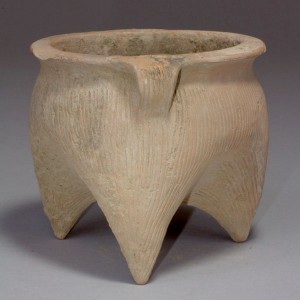As part of the John Young Museum of Art education initiative, the museum supports learning opportunities for students to access, research, and write about the collections housed in the museum. This is a short essay written by Marlene McVey, a graduate student in Archaeology and Museum Studies.
Yangshao Pottery Tradition, 5000 – 3000 B.C.
China, Henan Province, Central Yellow River
Ceramic, pigment
Gift of The John Young Foundation
The Yangshao culture is a complex culture that arose during the Neolithic period in China. The Yangshao people were millet farmers who took advantage of the rich soil of the flood plains surrounding the Yellow River. Aside from domesticating millet, they domesticated dogs and pigs, and supplemented their diet by fishing, hunting wild animals, and foraging wild plants. They lived in settled villages, had set graveyards for their dead, and developed exquisite handicrafts. Their primary craft production was pottery, and this is evident in the abundance of a variety of pottery vessels that have been unearthed through archaeological excavations (Liu, 2004).
The Yangshao people made two major types of pottery. The first is gray everyday earthenware used for cooking and eating, and was minimally decorated with cord, mat, or basket impressions. This type of pottery is known as “cord-marked” pottery and is found in Neolithic sites throughout China as well as many other parts of the world. The second type of pottery is highly decorated, and was most likely made primarily for funerary practices (Li, 2013). These highly decorated vessels, usually jars, have a lightly burnished surface decorated with painted designs in black, red, and brown. The decorations are generally simple geometric patterns, but they can be more ornate and include stylized fish, birds, and human faces. The artwork on their pottery is often abstract, and the knowledge of what they represent has been lost in time. Yangshao pottery is so distinct among the regional cultures of Neolithic China that the culture itself is often referred to as the “Painted-pottery Culture.” The painted potteries of this culture are the embodiment of the cultural and social complexity achieved by Neolithic cultures of the time.
About: Marlene McVey is a Graduate Student in Applied Archaeology at the University of Hawai’i Mānoa. She is also pursuing a graduate Museum Studies Certificate with a focus on collections management and Chinese archaeology.
References:
Li, Xinwei, “The Later Neolithic Period in the Central Yellow River Valley Area,” in A companion to Chinese archaeology, edited by Anne Underhill, 213-235. Malden [u.a.]: Wiley-Blackwell, (2013).
Liu, Li. (2004). The Chinese Neolithic: trajectories to early states. Cambridge, UK:Cambridge University Press.

